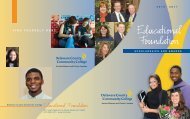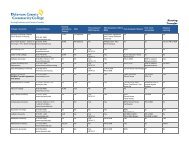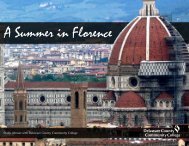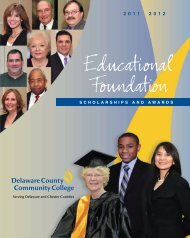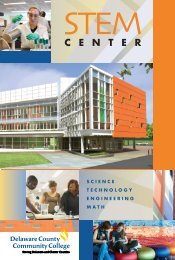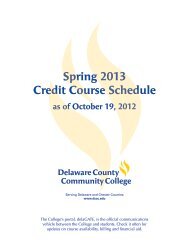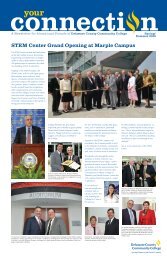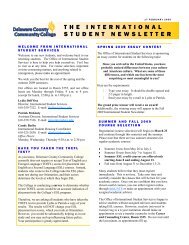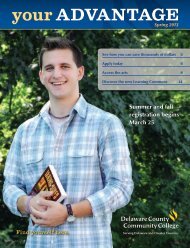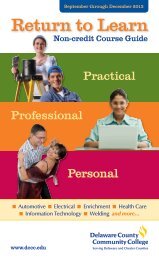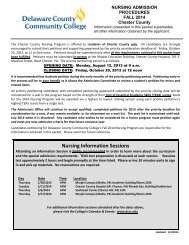2010 Catalog - Delaware County Community College
2010 Catalog - Delaware County Community College
2010 Catalog - Delaware County Community College
You also want an ePaper? Increase the reach of your titles
YUMPU automatically turns print PDFs into web optimized ePapers that Google loves.
116 COURSE DESCRIPTIONS<br />
ESS 102<br />
Introduction to Astronomy<br />
This course is designed to introduce students to the<br />
science of astronomy, its history, and its importance as an<br />
influence on our view of humankind. The course is<br />
intended for non-science majors. An optional laboratory<br />
course, ESS 103 Introduction to Astronomy Laboratory, is<br />
offered at night.<br />
Upon successful completion of this course, students<br />
should be able to:<br />
• Describe the night sky, the model used to represent it,<br />
and the motions of the sun, moon, and planets across it.<br />
• Trace the history of astronomy and the individuals and<br />
ideas that have shaped our view of the universe.<br />
• Describe the form in which information from the universe<br />
reaches astronomers, how the information is created, the<br />
tools used in astronomy to gather it, the concepts used to<br />
analyze it, and how the information is used to classify<br />
and study stars such as the sun.<br />
• Describe the important properties of stars, the methods<br />
by which astronomers measure those properties, and<br />
discuss the theories relating to stellar birth and evolution.<br />
• Describe the general characteristics of the solar system,<br />
the theories about its origin , how those theories are<br />
supported by observational evidence, and how the<br />
planets compare with one another in terms of their<br />
physical characteristics.<br />
• Discuss the discovery and nature of the Milky Way<br />
Galaxy, the different types of galaxies, their creation,<br />
organization, distribution, and motions in space, and<br />
how galaxies are used to develop theories regarding the<br />
creation and evolution of the universe.<br />
• Discuss the possibility of life existing elsewhere in the<br />
universe, what is presently known about the origins of<br />
life and suitable places for life to exist, and describe the<br />
observational evidence for or against life in the universe.<br />
Prereq. ENG 050 and REA 050<br />
3 Credits 3 Weekly Lecture Hours<br />
ESS 103<br />
Introduction to Astronomy<br />
Laboratory<br />
This laboratory course introduces students to astronomical<br />
observations through the use of telescopes and star charts<br />
to study objects in the night sky. Practical indoor activities<br />
are designed to foster an understanding of how objects<br />
from great distances are studied from the earth. Observations<br />
of the night sky with telescopes and the unaided<br />
eye will be conducted. Students will explore the constellations,<br />
moon, planets, and other objects of our universe.<br />
The course is intended for non-science majors, and is an<br />
optional laboratory course to accompany ESS 102<br />
Introduction to Astronomy.<br />
Upon successful completion of this course, students<br />
should be able to:<br />
• Identify stars, planets and constellations using the<br />
star charts.<br />
• Demonstrate proper use of telescope by reference to<br />
star charts.<br />
• Locate stellar objects with a telescope by reference to<br />
star charts.<br />
• Observe, record and analyze data collected from students<br />
observations as well as from observations of<br />
astronomical observatories.<br />
• Describe the nightly and annual motions of the moon,<br />
stars and planets.<br />
• Locate current information in journals and astronomical<br />
literature in the library.<br />
• Demonstrate the use of computer information systems<br />
such as Internet to collect and study recent data on<br />
astronomical events.<br />
• Describe several ways in which astronomers measure<br />
distance to stars.<br />
• Develop skills that can be used in life-long learning to<br />
understand the composition of our universe.<br />
Prereq. or Coreq. ESS 102<br />
1 Credit 2 Weekly Laboratory Hours<br />
ESS 110<br />
Geology<br />
This course is designed for Natural Science majors<br />
program although it will be appropriate for non-science<br />
majors as a laboratory science elective. The course<br />
provides an introduction to the study of the Earth, its<br />
composition, and the processes that shape it. The course<br />
will consider the various aspects of geology including<br />
earthquakes, volcanoes, surface and groundwater, rivers<br />
and streams, caves, landform development, plate tectonics,<br />
rocks, and minerals.<br />
Upon successful completion of this course, the student<br />
should be able to:<br />
• Identify volcanism, igneous activity, and the formation of<br />
igneous rocks.<br />
• Describe the processes of weathering, erosion,<br />
sedimentation, and the formation of sedimentary rocks.<br />
• Explain the basic ideas of metamorphism and the<br />
formation of metamorphic rocks.<br />
• Define the mechanism and effects of earthquakes.<br />
• Summarize the theory of plate tectonics.<br />
• Apply the plate tectonic theory to mountain building,<br />
volcanism, and earthquakes.<br />
• Compare surface water and groundwater, and explain the<br />
role of each in the human environment.<br />
• Describe the socioeconomic impact of geology.<br />
• Use the computer and the Internet to collect and apply<br />
information relating to geological processes.<br />
Prereq. MAT 060 and REA 050<br />
4 Credits 3 Weekly Lecture Hours<br />
2 Weekly Laboratory Hours<br />
ESS 111<br />
Observational Astronomy<br />
This course is designed for Natural Science majors<br />
although it will be appropriate for non-science majors as a<br />
laboratory science elective. Students will be introduced to<br />
astronomical concepts through observations, lectures and<br />
practical use of telescopes, CCD cameras and image<br />
processing to study objects in the night sky. Laboratory<br />
Observations and data collection of objects in night sky<br />
with telescopes, CCD cameras and other observational<br />
techniques will be made by the students to be used in<br />
lectures. Lectures and practical indoor activities on<br />
computer image processing of images taken by the<br />
students will be used to measure the position, brightness,<br />
motion and other data related to stellar and planetary<br />
objects. From these activities and observations gain an<br />
understanding of astronomy and how astronomers know<br />
what they know about the universe. Upon successful<br />
completion of this course, students should be able to:<br />
• Demonstrate proper use of telescopes and CCD cameras.<br />
• Describe process of astronomical imaging with the<br />
CCD cameras.<br />
• Measure the position of stars, planets and Moon with<br />
an astrolabe.<br />
• Observe, record and analyze data collected from students<br />
observations as well as from observations of<br />
astronomical observatories.<br />
• Demonstrate methods of image processing.<br />
• Locate current information in journals and astronomical<br />
literature in the library and on the Internet.<br />
• Presentation of final report.<br />
• Describe other methods of imaging and collecting<br />
astronomical data.<br />
• Explain how astronomers gain a knowledge and<br />
understanding of the stars and planets based on<br />
observations from here on Earth.<br />
• Develop skills that can be used in life-long enjoyment,<br />
appreciation and study of the heavens.<br />
Prereq. MAT 060 and REA 050<br />
4 Credits 3 Weekly Lecture Hours<br />
2 Weekly Laboratory Hours<br />
FRE 101<br />
(FRE) French<br />
Elementary French I<br />
The basic principles of pronunciation and grammar of<br />
the French language are emphasized. Vocabulary dealing<br />
with everyday situations is covered. Listening and<br />
speaking skills are developed through laboratory practice<br />
and increased use of French in the classroom.<br />
Upon successful completion of this course, students<br />
should be able to:<br />
• Reproduce with reasonable accuracy the sounds of<br />
the language.<br />
• Respond in French in a satisfactory manner to basic<br />
conversational situations.<br />
• Produce appropriate pattern and sentence transformation.<br />
• Write in dictation form with a reasonable degree of<br />
accuracy from materials that have already been studied.<br />
• Recall facts and observations of cultural interest.<br />
Fewer than two yrs H.S. French<br />
3 Credits 3 Weekly Lecture Hours<br />
FRE 102<br />
Elementary French II<br />
This course stresses progress in the speaking, writing<br />
and reading skills begun in FRE 101 and promotes<br />
greater understanding of French culture. The mandatory<br />
use of laboratory tapes further develops listening and<br />
speaking skills.<br />
Upon successful completion of this course, students<br />
should be able to:<br />
• Demonstrate an increased understanding of the<br />
principles of good pronunciation.<br />
• Show some facility in responding to familiar questions<br />
and requests given in French.<br />
• Demonstrate in reading and writing an understanding<br />
of grammatical concepts previously presented.<br />
• Exercise control of a larger vocabulary.<br />
• Write in dictation form from familiar texts.<br />
• Recall facts of culture contrasts shown in assigned reading.<br />
Prereq. FRE 101 or 2 yrs. H.S. French<br />
3 Credits 3 Weekly Lecture Hours<br />
FRE 111<br />
Intermediate French I<br />
Review of the basic sounds of the French language, firstlevel<br />
vocabulary and grammatical content. Introduction of<br />
new language concepts and more advanced vocabulary<br />
and idioms. Weekly laboratory practice to strengthen<br />
understanding of fluent speech.<br />
Upon successful completion of this course, students<br />
should be able to:<br />
• Demonstrate the ability to read directly in French with<br />
increasing attention to correctness of sounds, rhythm,<br />
accentuation and intonation.<br />
• Reproduce a representative number of the dialogue<br />
situations previously illustrated.<br />
• Demonstrate correct use of essential grammatical and<br />
idiomatic structures previously presented.<br />
• Produce original coherent sentences and short paragraphs.<br />
• Write familiar texts by dictation.<br />
• Identify patterns of cultural behavior or customs that have<br />
been presented in class discussions.<br />
Prereq. FRE 102 or equiv.<br />
3 Credits 3 Weekly Lecture Hours<br />
FRE 112<br />
Intermediate French II<br />
Focus on understanding new language principles and<br />
the identification of these concepts in reading and writing.<br />
Reading in French from a variety of practical, cultural and<br />
literary texts. Frequent listening and speaking practice.<br />
Weekly laboratory exercises for better understanding of<br />
fluent French.<br />
DELAWARE COUNTY COMMUNITY COLLEGE



